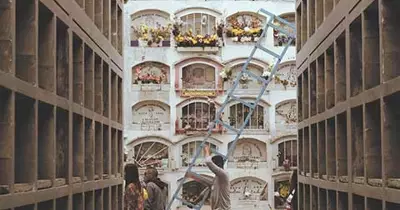
In the heart of Cebu, where ancient traditions meet modern life, an unexpected source of wisdom emerges from the city's resting places. Cemeteries, often seen as spaces of finality, are instead becoming classrooms for the living, teaching profound lessons about community, heritage, and what truly matters in life.
The Living Traditions of Remembering
Filipino funeral customs reveal a deep cultural tapestry woven with respect for ancestors and strong family connections. The practice of visiting gravesites isn't merely ritual—it's a living tradition that strengthens bonds across generations. Families gather not just to mourn, but to celebrate lives lived and maintain connections that transcend physical existence.
These traditions showcase the Filipino value of pakikipagkapwa-tao—the essential connection between people. The communal nature of mourning and remembrance reinforces how Filipinos view themselves not as isolated individuals, but as part of an interconnected web of relationships that continues even after death.
Environmental Consciousness in Sacred Spaces
Modern cemeteries in Cebu are evolving into spaces of environmental awareness. The shift toward more sustainable burial practices reflects a growing consciousness about our relationship with the earth. From green burial options to the maintenance of cemetery gardens, these spaces are teaching visitors about ecological responsibility and our role as stewards of the environment.
The careful tending of memorial gardens demonstrates how respect for the departed translates into care for living ecosystems. This environmental mindfulness serves as a powerful reminder that our actions today shape the world we leave for future generations.
Architecture as Historical Narrative
Cebu's cemeteries stand as open-air museums, their architecture telling stories of cultural evolution and historical transformation. The varying tomb designs—from simple markers to elaborate mausoleums—document changing artistic tastes, economic conditions, and social values across different eras.
These stone narratives provide tangible connections to Cebu's past, offering insights into how previous generations honored their dead and expressed their beliefs about the afterlife. The preservation of these spaces becomes crucial for maintaining cultural memory and understanding our collective journey.
Practical Wisdom for Daily Living
Beyond cultural and environmental lessons, cemeteries offer practical wisdom for navigating daily life:
- Perspective on Priorities: Walking among memorials provides clarity about what truly matters, helping visitors distinguish between temporary concerns and lasting values
- Appreciation for the Present: The constant reminder of life's finiteness encourages deeper appreciation for each moment and relationship
- Legacy Building: Seeing how lives are remembered inspires reflection on the marks we wish to leave on the world
- Community Strength: The collective nature of mourning and remembrance demonstrates the power of community support during life's challenges
A Space for Reflection and Renewal
Far from being morbid destinations, Cebu's cemeteries have transformed into spaces for contemplation and personal growth. Visitors often leave with renewed purpose and clearer perspectives on their life journeys. The quiet atmosphere provides a rare opportunity to step away from daily distractions and engage in meaningful self-reflection.
These sacred grounds challenge us to consider how we live, love, and contribute to our communities. They remind us that while physical life is temporary, the impacts we make and the relationships we nurture can create lasting legacies that continue to influence others long after we're gone.
In Cebu's cemeteries, the boundary between teaching and learning, between the living and the dead, becomes beautifully blurred—offering timeless wisdom for those willing to listen to the quiet lessons whispered between the tombstones.





